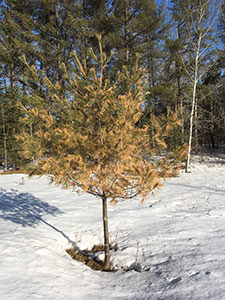A tough winter on trees
Winter drying injury on evergreens in northern Minnesota
By Megan O’Neil, Northwest Region forest health specialist
When the snow finally started to melt after this year’s long winter, many northern Minnesota residents noticed their evergreens showed signs of winter drying injury. Symptoms included needles that turned brown or looked bleached. We received many reports of white pines with brown needles on one side or just the upper portion of the tree.
Winter drying injury happens when water evaporates through openings in the needles. The water loss occurs because the tree’s roots are in frozen ground and unable to replenish the needles with water. Needle browning typically occurs from the tip downward to the base. Although it’s more of a problem on recently transplanted trees, winter drying injury also will affect established trees. Browning usually occurs on exposed upper branches, while lower branches protected by snow cover remain green.
Winter drying usually does not kill trees. As long as the buds are alive, the tree will produce new needles to replace the ones that have died.
If you have a yard tree that has signs of winter drying, you can prune out the dead tissue. To determine whether a limb is dead, simply use your thumbnail to scratch the bark and check for green tissue below. You also can check the buds for green living tissue.


Leave a Reply
You must be logged in to post a comment.